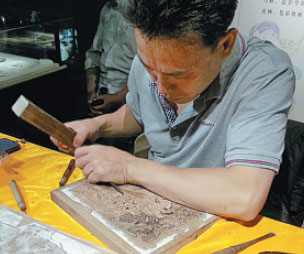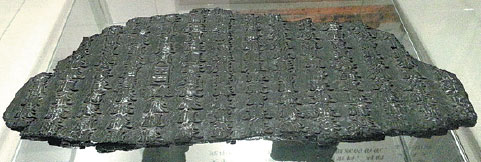Woodcuts highlight ancient printing
Updated: 2015-06-16 07:11
By Deng Zhangyu(China Daily USA)
|
||||||||
Ancient books are today rare, but even rarer are those wooden blocks used to print books hundreds of years ago. The show of precious printing blocks at the National Museum of Classic Books, which opened last week and runs through the end of July, features a large collection of the blocks known as woodcuts. It's the first and the most comprehensive exhibition of its kind in China.
On display are 147 blocks used for printing text, images and patterns collected by more than 10 Chinese museums, libraries, institutions and private collectors. In addition, 60 ancient books published by woodblock printing are also on show.
Block printing originated from the Tang Dynasty (AD 618-907), when Buddhist sutras were widely printed. People had to engrave characters on a block, and a book required hundreds of woodcuts to print. The world's earliest book is the Chinese scroll known as the Diamond Sutra, printed in 868 and now in the collection of the British Museum.
|
Above: The printing blocks show includes relics of wood blocks for printing of sutras in the Western Xia (1038-1227) regime. Below: A craftsman demonstrates the methods to engrave patterns on a wood block in the exhibition roomof the National Museum of Classic Books. Photos by Deng Zhangyu / China Daily |
The earliest woodcut in the show is from the Western Xia regime (1038-1227), unearthed in 1990 in a pagoda in the Ningxia Hui autonomous region. It was used to print an interpretative book of sutras. Blocks from the Qing Dynasty (1644-1911) reveal important medical texts passed down from the Song Dynasty (960-1279), when the spread of block printing reached its peak.
Woodcut printing was used for more than books. The technique was widely applied in daily life. Blocks in the exhibition were used to print posters, contracts, pictures for Spring Festival, marriage certificates and patterns to ward off diseases and troubles. Most blocks of this kind were used only once; they are more difficult to find than books.

"For quite a long time, we have ignored the importance of protecting printing blocks. But the show sends a message that China is beginning to rank the protection of blocks with that of ancient books," says An Pingqiu, an expert on ancient books.
An says that printing blocks need a large place to be stored and are hard to transport. Compared with ancient books, they're more difficult to protect and pass down.
Shi Jinbo, director of the research center of the culture of the Western Xia regime at the Chinese Academy of Social Sciences, says that there are many ancient books from the Song Dynasty, but the blocks are rare. The only existing block for the printing of ancient books in the Song Dynasty is in the United States. Germany, meanwhile, has the most blocks from the Western Xia regime.
"I suggest that China's block protection should start from private collectors. Shows of this kind are a good way to increase public awareness," says Shi.
The show also invites experienced craftsmen from ancient-book printing houses to demonstrate how to make woodcuts and demonstrate the process of printing.
This year, blocks for ancient book printing are on the protection list of China's rare ancient books, so institutions that collect these relics will receive government support and funding.
dengzhangyu@chinadaily.com.cn
(China Daily USA 06/16/2015 page8)

 Ten photos you don't wanna miss - June 16
Ten photos you don't wanna miss - June 16
 Shaolin monks harvest bumper crop
Shaolin monks harvest bumper crop
 Cambridge students mark end of exam with boat race
Cambridge students mark end of exam with boat race
 Village attracts tourists after first lady's visit
Village attracts tourists after first lady's visit
 Top 9 US-listed Chinese companies going private
Top 9 US-listed Chinese companies going private
 Hainan San Jose to Beijing: Ready for take-off
Hainan San Jose to Beijing: Ready for take-off
 Trending Across China: A Porsche gilded in gold
Trending Across China: A Porsche gilded in gold
 Paris Air Show: From Bombardier's new C Series to China Airlines
Paris Air Show: From Bombardier's new C Series to China Airlines
Most Viewed
Editor's Picks

|

|

|

|

|

|
Today's Top News
Jeb Bush announces bid for 2016 Republican presidential run
China, US develop new MERS treatment
China to complete land reclamation of construction on some Nansha Islands soon
Military launches drive to root out corruption in construction projects
China, US to kick off key talks next week
China, US sign agreement to boost army cooperation
City honors slain NYPD
Detective Liu
Chinese students on trial in alleged torture of peer
US Weekly

|

|
